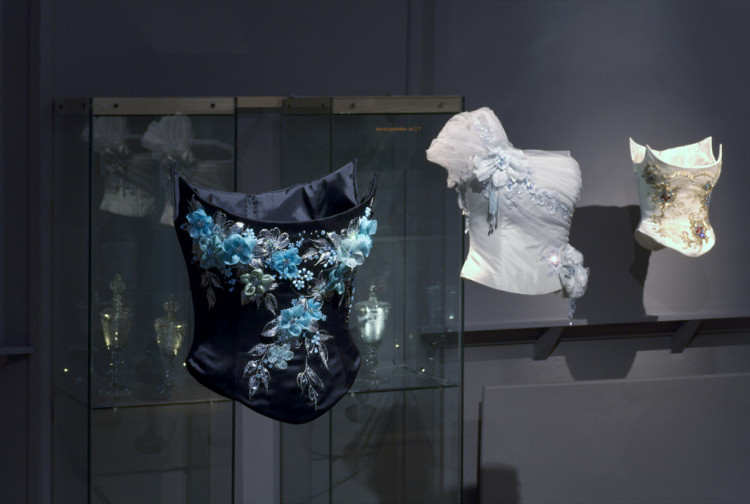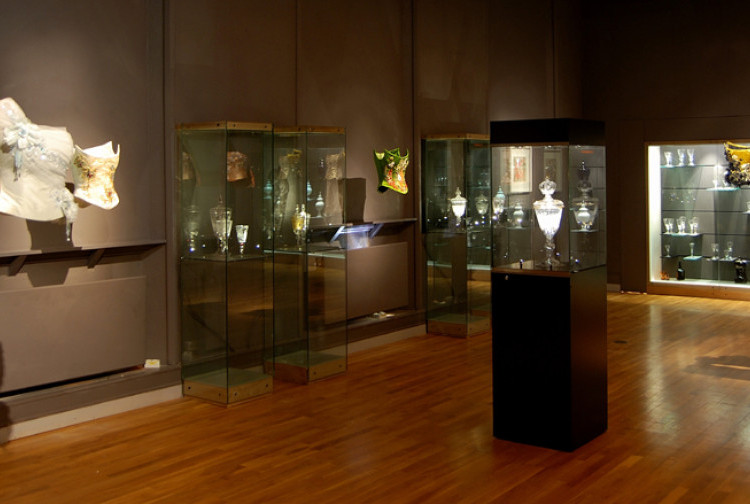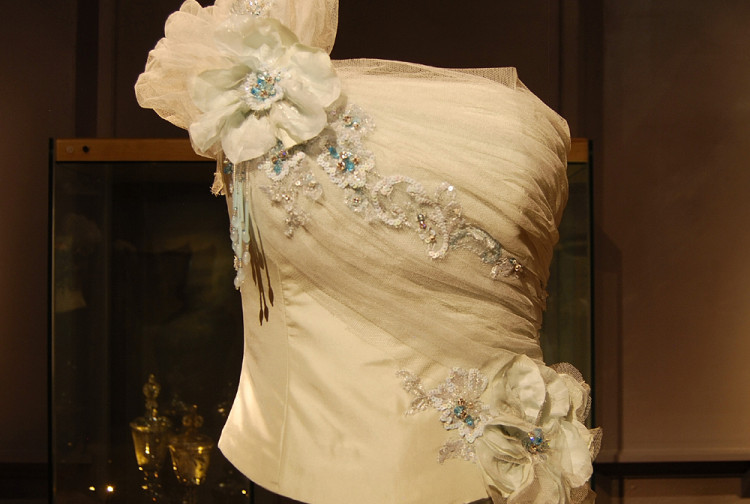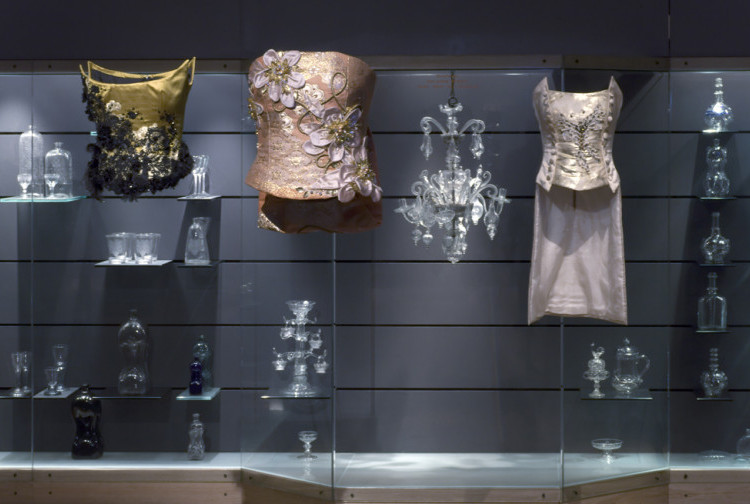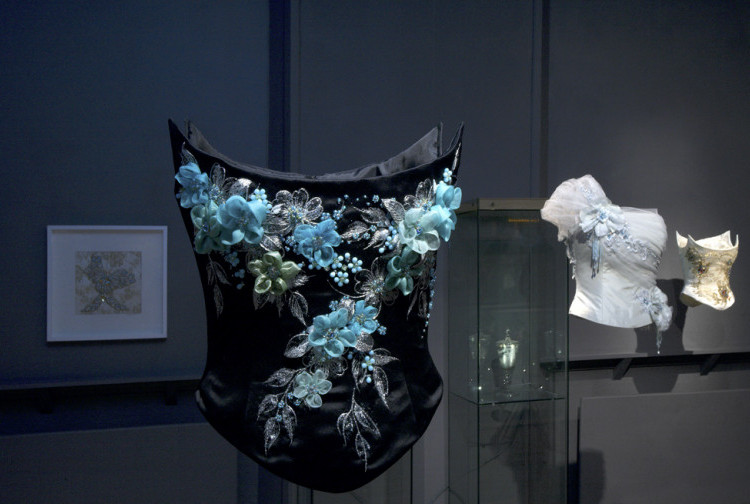Ove Harder Finseth in the Nøstetangen room
Textile art is medium-specific.
It is characterized by its stretchy materials and various craft techniques developed especially based on the requirements of the materials and the needs of the use. Textiles are used to cover, to clothe and to adorn. The artistic use of textiles in recent times goes in several directions, in the direction of fashion, tapestries, and as used in sculptures and installations. Ove Harder Finseth (b. 1965) is a fashion designer, tailor and sculptor. The decorative corsets he shows in a specially composed installation in the Nøstetangen room consist of corsets that can be used, but which are presented here for consideration, temporarily detached from the use function, but not disconnected from the phenomenology of fashion and feminine beauty.
The corsets are hung from the ceiling and we see that the shape of the object can be considered an abstract shape, but it reveals quite quickly that it is shaped like a shell around a woman's bust and waist. The relationship of textiles to the bodies - and in our western culture it is especially about the female bodies - became an important theme already in antiquity. The degree of development from Greek archaic to high-class style can be read in how freely the sculptors managed to create a three-dimensional female body and where the lifelike thin fabric of the dresses falls in folds over and makes visible the perfect body that wears it. The development went from rigid, frontal figures and geometrically engraved textile garments to lush bodies with light fabrics that show movement in limbs and air. In the Parthenon sculptures as they can be seen today in the British Museum in London, this is seen in perfect form. The perfect relationship between the female body and the textile becomes exemplary for our formidable, a lasting measure of beauty.
This connection - between female body beauty and the textile's possibilities of expression - continues to this day and constitutes the very basic theme in Finseth's ornamental corsets. Artfully designed and decorated garments are some of the most intimate objects imaginable. Ornamental garments are sensual symbols, and effective signals in the flirtatious interaction between the sexes, and not least, an important signal in the interaction within the gender. To the gaze the beautiful garment a woman desires is aimed at is as much other women's as men. This is not a roar with the feathers in the animals' roaring game, but a sophisticated and formed signal system that works in full public.
Ove Harder Finseth works in what is traditionally called the feminine sphere. His sensitivity stems from the Rococo, but perhaps especially from La Belle Epoche, from the period around 1900 which celebrated feminine grace and beauty to a degree history has never seen before. He has an extraordinary talent for ornamentation and he creates sumptuous and dazzlingly beautiful decoration on textile surfaces shaped by lines and arches in the female body. The ornaments and the embroidered, three-dimensional decor wind their way up the side of the garment in Art Nouveau, such as the Kalab flower on a glass vase or the gemstone-plated metal slings or flower wreaths that caress the female body in a painting by Gustav Klimt. The decor we can see on the corsets, in the form of sequins, crystals, metal wire, flowers or feathers, is moved by and tops the female beauty. They play the role of sublimated erogenous zones.
Ove Harder Finseth is an artist who is true to his medium and his metier. The fabrics and the sparkling rhinestones are his paint box and palette. The scissors and his needle brushes.
A celebration of the world's beauty and abundance has long been one of art's glorious traditions. Most contemporary artists today do not pay much attention to the visual beauty. These magnificent pieces become a counterweight to this. They also become an alternative to - and something other than - pop fashion, techno fashion, street fashion, causal wear, shabby chic, Marimekko, Unisex or Rødstrømpehabitt. This is textile art that is aimed at premieres, openings and parties.
The great thing about Nøstetangenrommet is precisely that it stands - among many other things - as a reservoir, not to mention a reserve - where the sensual, erogenous beauty is allowed to be itself. This exhibition shows how the elegant 18th century's elegant sense of form and decor - in glass, silver and faience - can still find its equivalent in a distinctive and highly original expression. The movements in the 18th century decor have a nerve that is still active and it grabs and is captured by the uniquely composed corsets in this exhibition. Each sculpture is unique, each with its own color and decor, and where the various elements elevate each other into one, united gestalt.
Ove Harder Finseth has a master's degree from the State School of Crafts and Industry (1997) and a diploma from the Ecole Chambre Syndicale de Couture in Paris (1993). He has practiced with Christian Lacroix in Paris and been employed by Kjell Torheim in Oslo. Since 1998, he has had his own studio at Grünerløkka in Oslo. Finseth works with collections for exhibitions and exhibitions and commissioned works for individual customers. He created the wedding dress for HRH Crown Princess Mette-Marit in 2001.
Ove Harder Finseth has participated in a number of exhibitions and his works have been purchased by e.g. Kunstindustrimuseet in Oslo and Nordenfjeldske kunstindustrimuseum in Trondheim, and he has received several awards, including Oslo City Culture Prize, 1st prize Comité Colbert for Givenchy in Paris, Fashion Award, Designer of the Year 2000 and Fashion Award, Professional Prize of the Year 2010.
Venue
Monday to Friday 11.00 - 15.00
Wednesday 11.00 – 18.00
Saturday 11.00 – 16.00 (free admission)
Sunday 11.00 – 16.00

